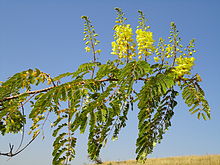Caesalpines
| Caesalpines | ||||||||||||
|---|---|---|---|---|---|---|---|---|---|---|---|---|

Peacock bush ( Caesalpinia pulcherrima ) |
||||||||||||
| Systematics | ||||||||||||
|
||||||||||||
| Scientific name | ||||||||||||
| Caesalpinia | ||||||||||||
| L. |
The Caesalpinias ( Caesalpinia ) are a genus of plants in the subfamily of the carob family (Caesalpinioideae) within the legume family (Fabaceae).
description
Appearance and leaves
The Caesalpinia species grow as trees , shrubs , climbing plants or, rarely, as herbaceous plants . They are often thorny. In many, but not all, species, the leaves and inflorescences are clustered on short shoots .
The alternate and spirally arranged leaves on the branches are composed: they are single or double pinnate. On the leaf rachis are the small to large pinna leaflets opposite or alternate. In some species the leaves are reduced to scales.
Inflorescences and flowers

There are lateral or terminal, racemose or ear-like inflorescences . Depending on the species, the flowers are small or large and are more or less zygomorphic . The flowers are hermaphroditic and five-fold with a double flower envelope . Of the five free sepals , the lowest is the largest. The five petals, which are yellow to orange to red in color, are spread out and often nailed; mostly four of them are circular or sometimes oblong, the top one is narrower and has a different shape, color and is downy hairy. There are two circles, each with five free stamens , of which mostly all are fertile and mostly half are significantly shorter than the others. The thick stamens are hairy at their base. The anthers are egg-shaped or elliptical. The single ovary contains one to seven ovules . The rod-shaped stylus ends in a scar that is trimmed or hollow in the center.
Fruits and seeds
Flattened or swollen, egg-shaped, elongated, lanceolate or sometimes sickle-shaped legumes are formed that are leathery or woody, rarely fleshy, smooth or, in some species, prickly. Depending on the species, they open when ripe or remain closed. The seeds are egg-shaped or spherical.
use
Caesalpinia spinosa (Tara) is grown in native South America ( Peru , Ecuador ) because of the suitability of its fruits as a thickening agent (see Tara gum ).
distribution
The genus Caesalpinia is widespread in tropical to subtropical zones.
Systematics
The French botanist Charles Plumier named the genus Caesalpinia in honor of the Italian botanist Andrea Cesalpino . Carl von Linné later took over this name. Synonyms for Caesalpinia L. are Cantuffa J.F.Gmel. , Denisophytum R.Vig. , Guilandina L. and Poinciana L. The genus Caesalpinia belongs to the tribe Caesalpinieae in the subfamily of the carob family (Caesalpinioideae) within the legume family (Fabaceae).
The delimitation of the genus is seen as controversial; depending on the author, it includes 70 to 165 species. Here is a selection of species:
- Caesalpinia angolensis (Oliv.) Herend. & Zarucchi
- Caesalpinia benthamiana (Baill.) Herend. & Zarucchi
- Caesalpinia bonduc (L.) Roxb.
- Caesalpinia brasiliensis L.
- Caesalpinia cacalaco Bonpl.
- Caesalpinia cassioides Willd.
- Caesalpinia ciliata (Wikstr.) Urb.
- Caesalpinia coriaria (Jacq.) Willd.
- Caesalpinia corymbosa Benth.
- Caesalpinia crista L.
- Caesalpinia cucullata Roxb.
- Caesalpinia decapetala (Roth) Alston
- Caesalpinia delphinensis Du Puy & R. Rabev.
- Caesalpinia digyna Rottler
- Brazil wood ( Caesalpinia echinata Lam. )
- Caesalpinia eriostachys Benth.
- Caesalpinia exostemma DC.
- Caesalpinia ferrea Mart. ex Tul.
- Caesalpinia gardneriana Benth.
- Bird of Paradise Bush ( Caesalpinia gilliesii (Hook.) D.Dietr. )
- Caesalpinia granadillo Pittier
- Caesalpinia hildebrandtii (Vatke) Baill.
- Caesalpinia jamesii (Torr. & A.Gray) Fisher
- Caesalpinia kavaiensis H. Mann
- Caesalpinia latisiliqua (Cav.) Hattink
- Caesalpinia madagascariensis (R.Vig.) Senesse
- Caesalpinia major (medic.) Dandy & Exell
- Caesalpinia mexicana A. Gray
- Caesalpinia microphylla Mart. ex G.Don
- Caesalpinia minax Hance
- Caesalpinia myabensis Britton
- Caesalpinia nipensis Urb.
- Caesalpinia palmeri S. Watson
- Caesalpinia paraguariensis (D. Parodi) Burkart
- Caesalpinia pauciflora (Griseb.) C. Wright
- Caesalpinia platyloba S. Watson
- Caesalpinia pluviosa DC.
- Caesalpinia pubescens (Desf.) Hattink
- Peacock shrub , also called Flamboyant, pride of Barbados or dwarf Poinciane, ( Caesalpinia pulcherrima (L.) Sw. , Syn .: Poinciana pulcherrima L. )
- Caesalpinia pumila (Britton & Rose) FJHerm.
- Caesalpinia punctata Willd.
- Caesalpinia pyramidalis Tul.
- Caesalpinia sappan L.
- Caesalpinia scortechinii (F. Muell.) Hattink
- Caesalpinia sessilifolia S. Watson
- Caesalpinia spinosa (Molina) Kuntze ("Tara", "Guarango")
- Caesalpinia velutina (Britton & Rose) Standl.
- Caesalpinia vernalis Champ. ex Benth.
- Caesalpinia vesicaria L.
- Caesalpinia violacea Standl.
- Caesalpinia yucatanensis Greenm.
swell
- L. Watson & MJ Dallwitz: Caesalpinia - entry at DELTA. (Section description)
- Dezhao Chen, Prof. Dianxiang Zhang & Ding Hou: Caesalpinia in the Flora of China , Volume 10, 2010, p. 41: Online. (Section description)
- Entry in the Flora of Pakistan . (English)
- Entry in the Flora of Australia Online . (English)
Individual evidence
- ^ Charles Plumier: Nova Plantarum Americanarum Genera . Leiden 1703, p. 28.
- ^ Carl von Linné: Critica Botanica . Leiden 1737, p. 92
- ^ List of species at GRIN - Taxonomy for Plants.
- ^ Entry in the Flora of Madagascar. (English)
Web links
- Entry in the Flora of Zimbabwe . (English)
- Description in the woody flora of the Andes of Ecuador. (span.)
- Entry at bgbm.org (German site, but in English)







